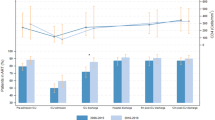Abstract
The purpose of this investigation was to analyse the impact of the availability of highly active antiretroviral therapy (HAART) on the long-term outcome of human immunodeficiency virus (HIV)-infected patients admitted to the intensive care unit (ICU). A retrospective cohort study of HIV-infected patients admitted to the ICU was undertaken. Outcomes in the pre-HAART era (1990–June 1996), early- (July 1996–2002), and recent-HAART (2003–2008) periods and total HAART era (July 1996–2008) were analysed and compared with those reported of the general population. A total of 127 ICU admissions were included. The 1-year mortality decreased from 71% in the pre-HAART era to 50% in the recent-HAART period (p = 0.06). The 5-year mortality decreased from 87% in the pre-HAART era to 59% in the early-HAART period (p = 0.005). Independent predictors of 1-year mortality in the HAART era were age (odds ratio [OR] = 1.16 [95% confidence interval [CI] = 1.06–1.27]), APACHE II score > 20 (6.04 [1.25–29.22]) and mechanical ventilation (40.01 [3.01–532.65]). The 5-year survival after hospitalisation was 80% and in the range of the reported survival of non-HIV-infected patients (83.7%). Predictors of 1-year mortality for HIV patients admitted to the ICU in the HAART era were all non-HIV-related. Short- and long-term outcome has improved since the introduction of HAART and is comparable to the outcome data in non-HIV-infected ICU patients.


Similar content being viewed by others
References
UNAIDS. Executive summary: 2008 report on the global AIDS epidemic. Available online at: http://www.unaids.org/en/dataanalysis/epidemiology/2008reportontheglobalaidsepidemic/
van Leeuwen HJ, Boereboom FT, Pols MA, Hoepelman AI, Savelkoul JT (2000) Factors predicting survival for HIV-infected patients with respiratory failure. Neth J Med 57:74–81
Staikowsky F, Lafon B, Guidet B, Denis M, Mayaud C, Offenstadt G (1993) Mechanical ventilation for Pneumocystis carinii pneumonia in patients with the acquired immunodeficiency syndrome. Is the prognosis really improved? Chest 104:756–762
Rogers PL, Lane HC, Henderson DK, Parrillo J, Masur H (1989) Admission of AIDS patients to a medical intensive care unit: causes and outcome. Crit Care Med 17:113–117
Kumar SD, Krieger BP (1998) CD4 lymphocyte counts and mortality in AIDS patients requiring mechanical ventilator support due to Pneumocystis carinii pneumonia. Chest 113:430–433
Nickas G, Wachter RM (2000) Outcomes of intensive care for patients with human immunodeficiency virus infection. Arch Intern Med 160:541–547
Narasimhan M, Posner AJ, DePalo VA, Mayo PH, Rosen MJ (2004) Intensive care in patients with HIV infection in the era of highly active antiretroviral therapy. Chest 125:1800–1804
Palella FJ Jr, Delaney KM, Moorman AC, Loveless MO, Fuhrer J, Satten GA, Aschman DJ, Holmberg SD (1998) Declining morbidity and mortality among patients with advanced human immunodeficiency virus infection. HIV Outpatient Study Investigators. N Engl J Med 338:853–860
Jensen-Fangel S, Pedersen L, Pedersen C, Larsen CS, Tauris P, Møller A, Sørensen HT, Obel N (2004) Low mortality in HIV-infected patients starting highly active antiretroviral therapy: a comparison with the general population. AIDS 18:89–97
Lewden C, Chene G, Morlat P, Raffi F, Dupon M, Dellamonica P, Pellegrin JL, Katlama C, Dabis F, Leport C (2007) HIV-infected adults with a CD4 cell count greater than 500 cells/mm3 on long-term combination antiretroviral therapy reach same mortality rates as the general population. J Acquir Immune Defic Syndr 46:72–77
Antiretroviral Therapy Cohort Collaboration (2008) Life expectancy of individuals on combination antiretroviral therapy in high-income countries: a collaborative analysis of 14 cohort studies. Lancet 372:293–299. doi:10.1016/S0140-6736(08)61113-7
Casalino E, Wolff M, Ravaud P, Choquet C, Bruneel F, Regnier B (2004) Impact of HAART advent on admission patterns and survival in HIV-infected patients admitted to an intensive care unit. AIDS 18:1429–1433
Dickson SJ, Batson S, Copas AJ, Edwards SG, Singer M, Miller RF (2007) Survival of HIV-infected patients in the intensive care unit in the era of highly active antiretroviral therapy. Thorax 62:964–968
Powell K, Davis JL, Morris AM, Chi A, Bensley MR, Huang L (2009) Survival for patients with HIV admitted to the ICU continues to improve in the current era of combination antiretroviral therapy. Chest 135:11–17
Coquet I, Pavie J, Palmer P, Barbier F, Legriel S, Mayaux J, Molina JM, Schlemmer B, Azoulay E (2010) Survival trends in critically ill HIV-infected patients in the highly active antiretroviral therapy era. Crit Care 14:R107. doi:10.1186/cc9056
Palacios R, Hidalgo A, Reina C, de la Torre M, Márquez M, Santos J (2006) Effect of antiretroviral therapy on admissions of HIV-infected patients to an intensive care unit. HIV Med 7:193–196
Morris A, Creasman J, Turner J, Luce JM, Wachter RM, Huang L (2002) Intensive care of human immunodeficiency virus-infected patients during the era of highly active antiretroviral therapy. Am J Respir Crit Care Med 166:262–267
Knaus WA, Draper EA, Wagner DP, Zimmerman JE (1985) APACHE II: a severity of disease classification system. Crit Care Med 13:818–829
Vincent JL, Moreno R, Takala J, Willatts S, De Mendonça A, Bruining H, Reinhart CK, Suter PM, Thijs LG (1996) The SOFA (Sepsis-related Organ Failure Assessment) score to describe organ dysfunction/failure. On behalf of the Working Group on Sepsis-Related Problems of the European Society of Intensive Care Medicine. Intensive Care Med 22:707–710
Hoste EA, Clermont G, Kersten A, Venkataraman R, Angus DC, De Bacquer D, Kellum JA (2006) RIFLE criteria for acute kidney injury are associated with hospital mortality in critically ill patients: a cohort analysis. Crit Care 10:R73. doi:10.1186/cc4915
[No authors listed] (1992) 1993 revised classification system for HIV infection and expanded surveillance case definition for AIDS among adolescents and adults. MMWR Recomm Rep 41:1–19
Ferreira FL, Bota DP, Bross A, Mélot C, Vincent JL (2001) Serial evaluation of the SOFA score to predict outcome in critically ill patients. JAMA 286:1754–1758
Palella FJ Jr, Baker RK, Moorman AC, Chmiel JS, Wood KC, Brooks JT, Holmberg SD; HIV Outpatient Study Investigators (2006) Mortality in the highly active antiretroviral therapy era: changing causes of death and disease in the HIV outpatient study. J Acquir Immune Defic Syndr 43:27–34. doi:10.1097/01.qai.0000233310.90484.16
Croda J, Croda MG, Neves A, De Sousa dos Santos S (2009) Benefit of antiretroviral therapy on survival of human immunodeficiency virus-infected patients admitted to an intensive care unit. Crit Care Med 37:1605–1611
Niskanen M, Kari A, Halonen P (1996) Five-year survival after intensive care—comparison of 12,180 patients with the general population. Finnish ICU Study Group. Crit Care Med 24:1962–1967
Wright JC, Plenderleith L, Ridley SA (2003) Long-term survival following intensive care: subgroup analysis and comparison with the general population. Anaesthesia 58:637–642
Williams TA, Dobb GJ, Finn JC, Knuiman MW, Geelhoed E, Lee KY, Webb SA (2008) Determinants of long-term survival after intensive care. Crit Care Med 36:1523–1530
Corona A, Raimondi F (2010) Critical care of HIV-infected patients: still a dilemma for Italian intensivists—results of a multicentre survey. Eur J Anaesthesiol 27:377–382
Author information
Authors and Affiliations
Corresponding author
Additional information
S.F.L. van Lelyveld and C.M. Wind contributed equally to this work.
Rights and permissions
About this article
Cite this article
van Lelyveld, S.F.L., Wind, C.M., Mudrikova, T. et al. Short- and long-term outcome of HIV-infected patients admitted to the intensive care unit. Eur J Clin Microbiol Infect Dis 30, 1085–1093 (2011). https://doi.org/10.1007/s10096-011-1196-z
Received:
Accepted:
Published:
Issue Date:
DOI: https://doi.org/10.1007/s10096-011-1196-z




